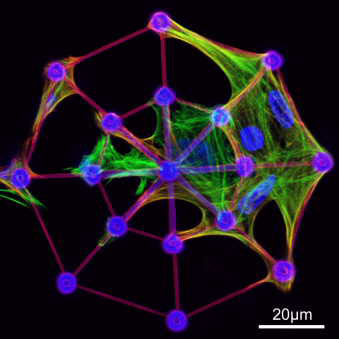| Posted: June 8, 2009 |
Karlsruhe Institute of Technology launches new 'key technology' research program 'BioInterfaces' |
|
(Nanowerk News) BioInterfaces represents an ambitious new “Key Technologies” research programme supported by the Helmholtz Association, the largest German scientific funding organization. The programme brings together a team of biologists, chemists, physicists, materials scientists and informaticians. With an annual budget of approximately 20 Million Euro, the 67 research teams will work closely together to develop innovative tools and technologies for precisely controlling the behaviour of cells.
|
 |
| Growing cells in a coated, three-dimensionsl glas structure (Image: Franziska Klein/Martin Bastmeyer, Universität Karlsruhe)
|
|
This will lead, for example, to new ways of growing stem cells, or manipulating cells in the organism and in bioreactor systems. These key technologies will ultimately contribute to the development of new therapies for many degenerative diseases that affect muscle, the retina or the central nervous system. In addition, BioInterfaces aims to control or inhibit bacterial cells that form biofilms on man-made surfaces, another area of immense technical relevance.
|
|
“The basic philosophy of the BioInterfaces programme is to learn from nature and then copy it. So, the first stage of our strategy involves a focused, innovative, large-scale analysis to learn more about the natural control mechanisms of cells and how optimally to manipulate them”, says Professor Uwe Strähle, speaker of the program and head of the Institute of Toxicology and Genetics. “This will be achieved by a close partnership between biologists and technology developers. In the subsequent stages, multifunctional molecular devices or advanced surface modifications will be designed and built in order to target and interact with the key molecular control points and thereby to control cell behaviour.”
|
|
The interdisciplinary nature of the BioInterfaces programme demands a new generation of scientists. The programme has therefore just launched the BioInterfaces Postgraduate School that will provide interdisciplinary training for approximately 90 PhD students. Students will be offered introductory courses covering all the participating disciplines. This school will foster cross-talk between the BioInterfaces research fields through the funding of interdisciplinary and “twinning” student projects.
|
|
|
|
Reflecting the Helmholtz research philosophy, the BioInterfaces researchers have access to or operate large scale infrastructures such as the largest fish facility in Europe, the ANKA synchrotron radiation source, a large computing and data storage facility, micro- and nano-fabrication facilities, and advanced surface analysis technology. The programme is based at the campus north of KIT, the Forschungszentrum Karlsruhe. This large Helmholtz research center encompasses a research expertise in micro- and nanotechnology but is also the home for basic biology research. Importantly, BioInterfaces establishes a regional focus since it involves a strong partnership with the University of Heidelberg, recently promoted to the “elite class” of German universities. Strategically, BioInterfaces represents a key programme that demonstrates the great potential offered by KIT.
|
|
The Karlsruhe Institute of Technology (KIT) is the merger of the Forschungszentrum Karlsruhe, member of the Helmholtz Association, and the Universität Karlsruhe. This merger will give rise to an institution of internationally excellent research and teaching in natural and engineering sciences. In total, the KIT has 8000 employees and an annual budget of 700 million Euros. The KIT focuses on the knowledge triangle of research – teaching – innovation.
|
|
The Karlsruhe institution is a leading European energy research center and plays a visible role in nanosciences worldwide. KIT sets new standards in teaching and promotion of young scientists and attracts top scientists from all over the world. Moreover, KIT is a leading innovation partner of industry.
|

